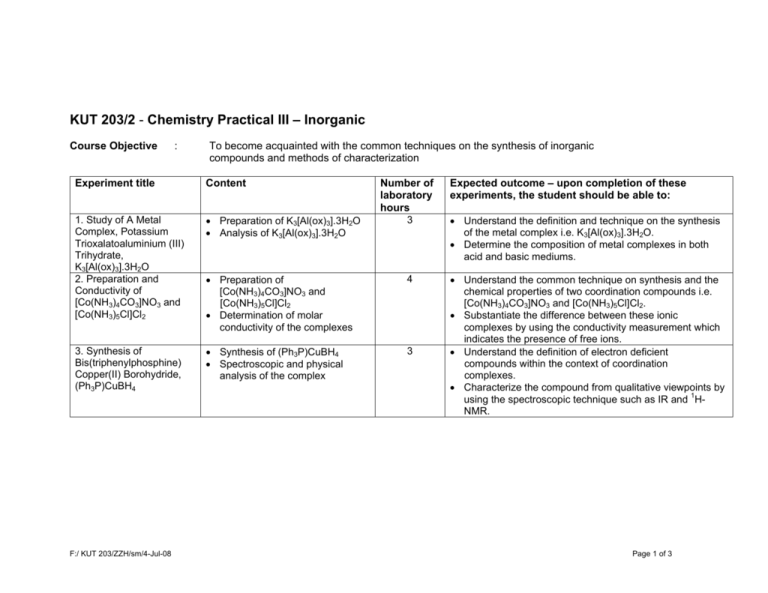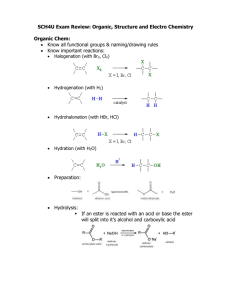KUT 203/2 - Chemistry Practical III (Inorganic Chemistry)
advertisement

KUT 203/2 - Chemistry Practical III – Inorganic Course Objective : To become acquainted with the common techniques on the synthesis of inorganic compounds and methods of characterization Experiment title Content 1. Study of A Metal Complex, Potassium Trioxalatoaluminium (III) Trihydrate, K3[Al(ox)3].3H2O 2. Preparation and Conductivity of [Co(NH3)4CO3]NO3 and [Co(NH3)5Cl]Cl2 • Preparation of K3[Al(ox)3].3H2O • Analysis of K3[Al(ox)3].3H2O • Preparation of [Co(NH3)4CO3]NO3 and [Co(NH3)5Cl]Cl2 • Determination of molar conductivity of the complexes 4 3. Synthesis of Bis(triphenylphosphine) Copper(II) Borohydride, (Ph3P)CuBH4 • Synthesis of (Ph3P)CuBH4 • Spectroscopic and physical analysis of the complex 3 F:/ KUT 203/ZZH/sm/4-Jul-08 Number of laboratory hours 3 Expected outcome – upon completion of these experiments, the student should be able to: • Understand the definition and technique on the synthesis of the metal complex i.e. K3[Al(ox)3].3H2O. • Determine the composition of metal complexes in both acid and basic mediums. • Understand the common technique on synthesis and the chemical properties of two coordination compounds i.e. [Co(NH3)4CO3]NO3 and [Co(NH3)5Cl]Cl2. • Substantiate the difference between these ionic complexes by using the conductivity measurement which indicates the presence of free ions. • Understand the definition of electron deficient compounds within the context of coordination complexes. • Characterize the compound from qualitative viewpoints by using the spectroscopic technique such as IR and 1HNMR. Page 1 of 3 Experiment title Content 4. Complex Ion Composition Using Job’s Method • Preparation of Ni(II) complex solution with different mole fraction of ligand (ethylenediamine) • Determination of mole ratio of Ni:ligand by UV-Vis spectroscopic technique • Preparation of standard solution of vanadium(V) complex • Reduction of vanadium(V) by zinc (without air), zinc and sulfur dioxide • Identification of ionic vanadium species through the presence of various colors in solution • Preparation of coordination compounds: potassium tris(oxalate)chromate(III) trihydrate and potassium hexathiocyanato chromate(III) tetrahydrate • Study on the electronic properties of Cr(III) complexes by UV-Vis spectroscopic technique • Investigation of the ligand field splitting energy in each complex via the determination of Δoct 5. The Chemistry of Vanadium 6. Electronic Spectra of Coordination Compounds F:/ KUT 203/ZZH/sm/4-Jul-08 Number of laboratory hours 2 3 4 Expected outcome – upon completion of these experiments, the student should be able to: • Synthesize and isolate the complex containing free ions in the solution. • Apply continuous variation method or Job’s method in investigating the composition of complex ions. • Understand the chemical properties of the first row d-block metal i.e. vanadium. • Understand the correlation between the colors of transition metal or metal ion with its oxidation state i.e. VO2+ (yellow), VO2+ (blue) etc. • Determine the composition of a metal complex of which the metal exists in various oxidation states by using the titration technique. • Synthesize several coordination compounds which possess different ligands either within or outside the coordination sphere i.e.K3[Cr(C2O4)3].3H2O and K3[Cr(SCN)6].4H2O. • Understand the field strength among different ligands such as C2O4, H2O, SCN etc. • Understand the concept on electronic transition among these complexes which can be inferred from the UV-Vis spectra. • Calculate the ligand field splitting energy (Δoct) which serve to substantiate the field strength among these ligands. Page 2 of 3 Experiment title Content 7. Preparation and Reaction of Tris(ethylenediamine)cobalt (III) into Its Optical Antipode • Preparation of barium d-tartrate • Molecular rotation determination for the two diastereomers • Determination of percent composition of iodide in complex 8. Characterisation of the Linkage Isomers: Nitropentaamminecobalt(III) Chloride, [Co(NH3)5NO2]Cl2, and Nitritopentaamminecobalt(III) Chloride, [Co(NH3)5ONO]Cl2 9. The Electronic Spectra of Some Copper(II) complexes • • • • F:/ KUT 203/ZZH/sm/4-Jul-08 Preparation of [Co(NH3)5Cl]Cl2 Preparation of the X isomer Preparation of the Y isomer Determination of the infrared spectrum • Preparation of [Cu(NH3)4]SO4.H2O • Preparation of K2[Cu(ox)2].2H2O • Preparation of [N(CH3)4]2[CuCl4] • Study on the electronic properties of Cu(II) complexes by UV-Vis spectroscopic technique • Study on the spectrochemical series based on ligand field splitting energy Δoct TOTAL Number of laboratory hours 11 5 6 Expected outcome – upon completion of these experiments, the student should be able to: • Understand the concept on optical isomerism in coordination compounds and the synthesis of these isomers or isolation of D- and L-isomers. • Determine the composition of isomers thus isolated through titration. • Substantiate the optical behaviour of these isomers. • Understand the concept on lingkage isomerism in coordination compounds and the technique used in the synthesis and isolation of these complex ions i.e. [(NH3)5CoNO2]Cl2 and [(NH3)5CoONO]Cl2. • Substantiate the functional group present in the isomers using the spectroscopic technique such as IR. • Understand the absorption of UV-Vis radiation by the transition metal complexes which results in the electronic transition among d orbitals of the central metal. • Understand the connectivity between the types of ligands and its Δ values which corresponds to the d-orbital splitting for these complexes. • Understand the concept on how to derive the spectrochemical series for some common ligands. 41 Page 3 of 3








![[Co(NH3)5NO2]Cl2.](http://s3.studylib.net/store/data/008421857_1-fdd1d8d51fc5069d9da132e10aa3f7ba-300x300.png)